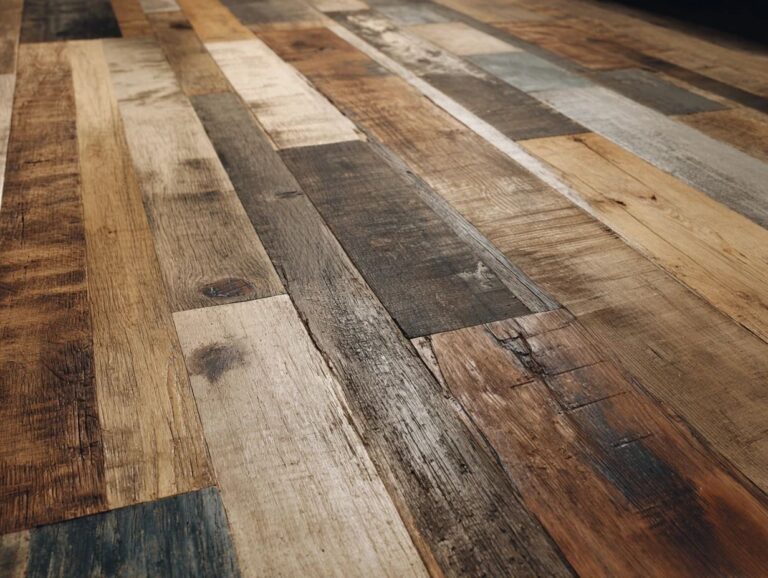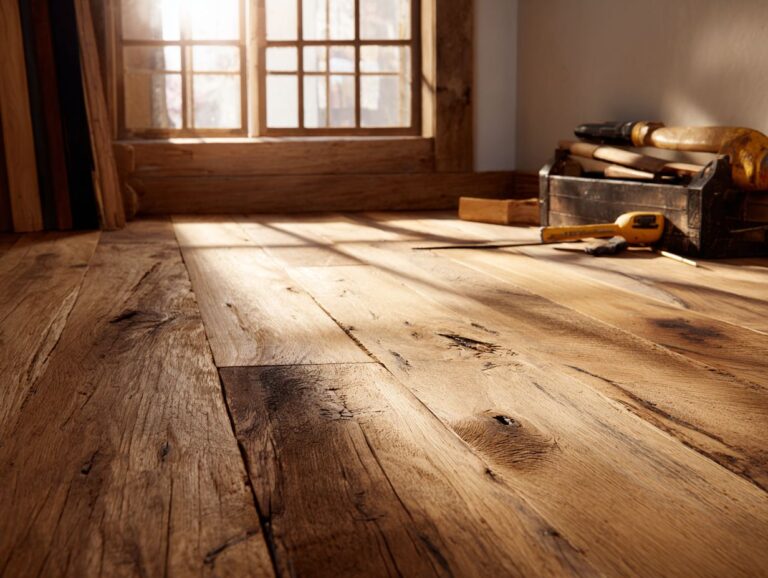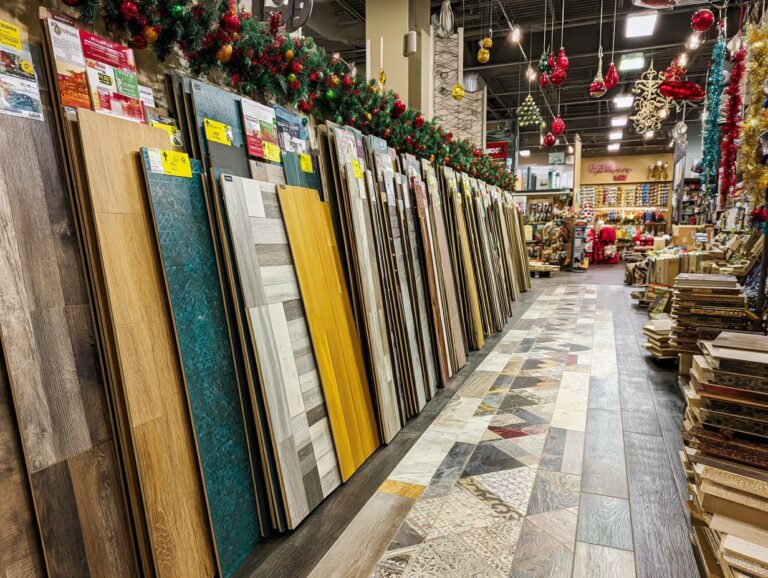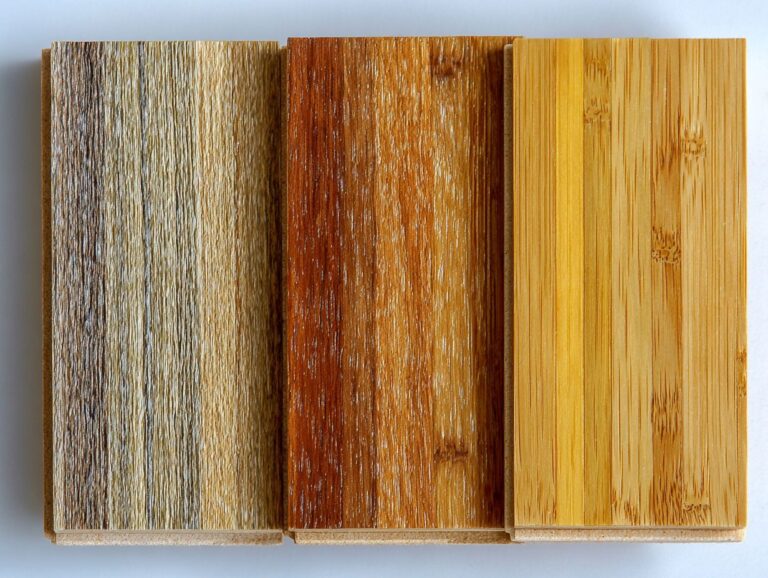Textured Laminate Options – Hand-Scraped, Embossed & Smooth
Do you want to improve your room with beautiful laminate flooring? Textured laminate options, including hand-scraped, embossed, and smooth laminate, offer a variety of design aesthetics perfect for any home. Retailers like Lowe’s offer a wide range of laminate flooring, making it simple to choose the best option. In this article, we’ll examine the detailed characteristics of each textured laminate type to help you select the best option for your next flooring project.
Key Takeaways:
Contents
Definition of Textured Laminate
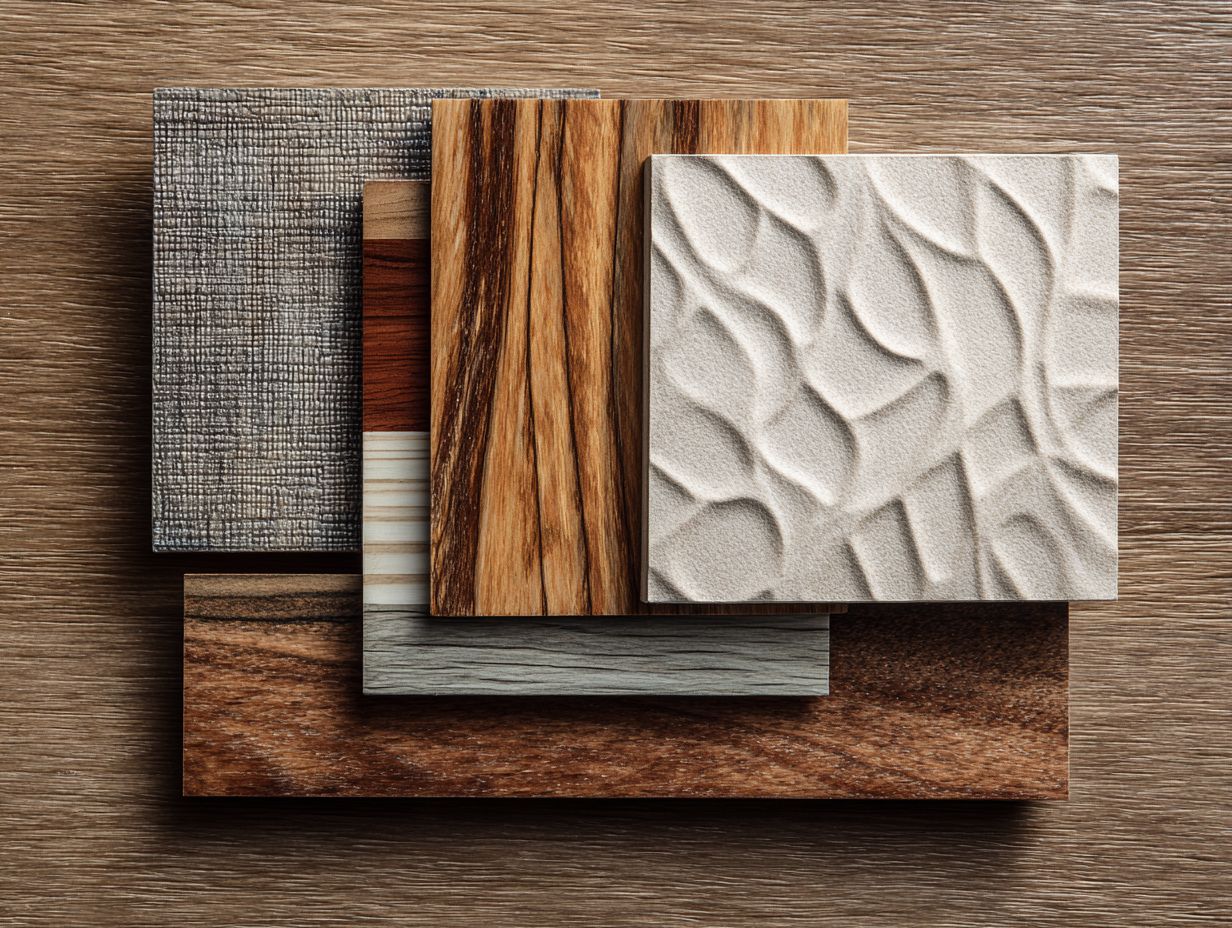
Textured laminate is a type of laminate flooring with surface differences that make it look and feel better than flat options.
This type of laminate mimics natural materials like wood or stone, providing a more authentic aesthetic. For instance, textured planks can feature grooves and knots, enhancing visual depth.
Homeowners looking to install textured laminate can consider brands like Pergo or Mohawk, which offer various styles and finishes. The texture improves the appearance and reduces slipperiness, making the surface safer in crowded places.
When choosing, make sure it matches your current decor and is strong enough to last.
Importance of Texture in Laminate Design
Texture is important in laminate design because it affects how flooring looks and feels in homes.
Textured surfaces, such as handscraped or brushed finishes, can create a warm, inviting ambiance that mimics natural wood.
For example, a handscraped texture introduces depth and dimension, enhancing the rustic charm of a living room. A brushed finish provides a sleek, contemporary appearance, perfect for minimalistic designs.
To get these effects, look at laminate collections from brands like Pergo or Mohawk, which provide different textures suited to a range of styles.
In the end, the right texture can improve the flooring and the overall feel of the room.
Hand-Scraped Laminate
Hand-scraped laminate gives a rustic feel, imitating the natural flaws typically seen in traditional hardwood floors.
Overview of Hand-Scraped Technique
The hand-scraped technique involves individually distressing laminate planks to create depth and character, resembling authentic wood.
This process starts by selecting high-quality laminate boards. Workers use chisels and hammers to create intentional lines and dents on the surface.
For instance, a chisel can be employed to carve fine lines, while a hammer is used for broader dents. After this, a coating is added to make the texture and color better and more durable.
This careful workmanship improves the look and creates a special product that is noticeable in any room, combining rustic style with modern use.
Benefits of Hand-Scraped Laminate
Hand-scraped laminate is durable and visually appealing, making it ideal for busy areas.
Its durable surface resists scratches and dents, making it perfect for homes with pets or kids.
With a water-resistant core, hand-scraped laminate also works well in kitchens and bathrooms.
For easy maintenance, simply sweep regularly and use a damp mop for deeper cleaning.
Brands like Mohawk and Pergo offer various styles, with costs typically ranging from $2 to $4 per square foot.
This affordable yet stylish flooring can mimic the look of hardwood, providing both beauty and practicality.
Design Aesthetics of Hand-Scraped Laminate
The design aesthetics of hand-scraped laminate cater to rustic interiors and modern design, providing versatility in styling options.
This type of flooring mimics the appearance of authentic hardwood but with greater durability and ease of maintenance.
For a vintage farmhouse look, pair hand-scraped laminate with distressed furniture and muted color palettes. In contrast, for contemporary spaces, consider sleek, minimalist designs, perhaps incorporating metal accents.
Popular choices include warm oak tones combined with white or gray walls, creating a cozy yet modern ambiance. Using area rugs can help delineate spaces while enhancing the overall style.
Common Applications for Hand-Scraped Laminate
Common applications for hand-scraped laminate include high-traffic areas such as living rooms, kitchens, and hallways, where durability meets style.
For long-lasting durability, choose hand-scraped laminate flooring in areas that may get scratched or wet. For kitchen installations, choose water-resistant options that can withstand moisture.
In hallways, consider using a thicker underlayment for additional cushioning and sound absorption.
When installing, follow these steps:
- First, acclimate the planks for 48 hours in the room;
- Second, use a dependable miter saw for accurate cuts;
- And finally, keep a gap of at least 1/4 inch around walls to allow for expansion.
These practices greatly improve strength and appearance.
Embossed Laminate
Embossed laminate offers different textures that mimic the appearance of real wood and stone, attracting homeowners who want genuine-looking materials.
Understanding the Embossing Process
The embossing process involves creating raised patterns on the laminate surface, enhancing its tactile and visual appeal.
To manufacture embossed laminate, manufacturers typically use a combination of heat and pressure, often utilizing a hydraulic press.
First, a base layer of laminate is prepared with an initial coating. The embossed design, made on a cylinder or die, is then heated and pressed onto the laminate to create the raised patterns.
Rotary screen printing is suitable for detailed patterns. This process creates different textures, like wood grains or geometric shapes, giving a custom finish that works well for flooring, cabinets, and furniture design.
Advantages of Embossed Laminate
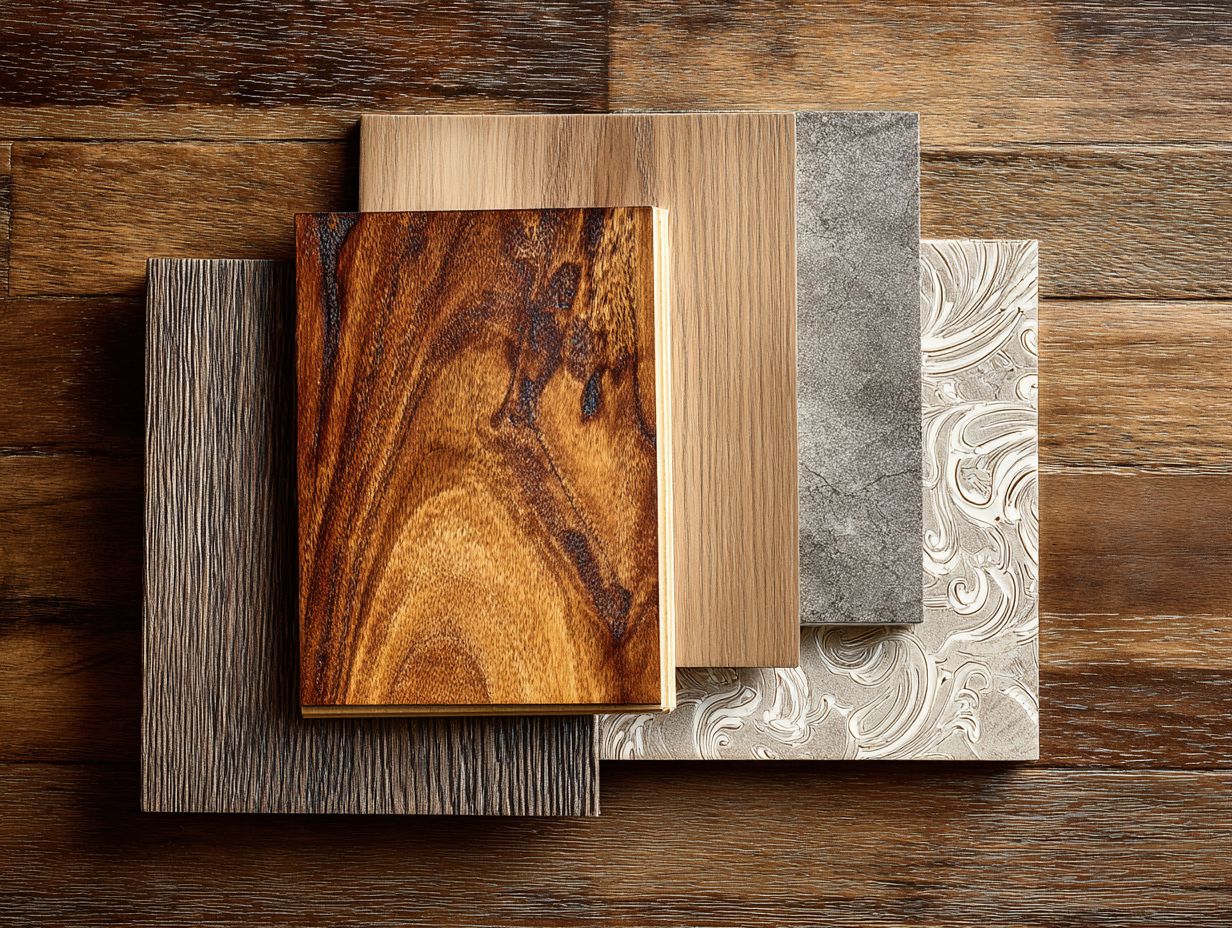
Embossed laminate offers advantages such as improved moisture resistance and extra texture, making it fit for various environments.
This makes embossed laminate ideal for high-humidity areas like kitchens and bathrooms. Its moisture-resistant properties prevent warping and deterioration, ensuring durability over time.
For example, using embossed laminate on kitchen countertops can improve both practicality and style, offering a textured surface that matches modern looks. You can clean it easily with just a damp cloth, which makes it a good option for busy homes.
Consider pairing it with moisture-resistant adhesives during installation for optimal performance in damp conditions.
Texture Variations in Embossed Laminate
Texture variations in embossed laminate range from subtle to dramatic, allowing homeowners to tailor their flooring choices to match their design preferences.
Subtle textures like fine grain can create a warm, inviting atmosphere, ideal for cozy living spaces. In contrast, noticeable textures like deep grooves or detailed patterns can be prominent features in modern interiors.
Homeowners should also consider the finish; a matte surface can offer a more understated look, while a gloss finish brings vibrancy and reflects light, enhancing the overall aesthetic.
When selecting, purchase samples from local retailers to visualize how each texture complements your existing decor and lighting before committing.
Ideal Uses for Embossed Laminate
Ideal uses for embossed laminate include areas that require durability and aesthetic appeal, such as family rooms and entryways.
Embossed laminate works well in busy spaces as it doesn’t scratch or stain easily, making it a good choice for families with lively households.
For instance, consider using it in a living room where children play or by an entryway prone to dirt and wear.
It can easily complement various decor styles-ranging from rustic to contemporary-thanks to a wide array of textures and finishes.
Brands like Pergo and Authentik offer options specifically designed to mimic the look of natural wood or stone, ensuring seamless integration with your existing design.
Smooth Laminate
Smooth laminate looks sleek and fits well with contemporary interior styles, while being low maintenance, as highlighted in our detailed piece on laminate manufacturing techniques.
Characteristics of Smooth Laminate
Smooth laminate has a shiny finish, is easy to clean, and looks simple, making it perfect for modern spaces.
Smooth laminate offers excellent durability, resisting scratches and dents, which is perfect for high-traffic areas.
For homeowners with pets or children, brands like Formica and Wilsonart provide options with antibacterial properties, ensuring a hygienic environment.
Putting it in is simple and usually doesn’t need unique tools-just a saw and glue for most people who like doing things themselves.
The wide range of colors and textures available allows for seamless integration into any dcor, enhancing the aesthetic without overwhelming the space.
Pros and Cons of Smooth Laminate
The pros of smooth laminate include easy maintenance and a contemporary look, while cons can involve susceptibility to scratches and less visual interest.
To evaluate smooth laminate flooring effectively, consider these aspects.
For maintenance, simply sweep or vacuum regularly and use a damp mop for deeper cleaning. Be cautious with water exposure as it can cause warping.
In terms of scratch resistance, investing in higher grades (AC3 or AC4) can improve durability.
If you want more visual appeal, look at textures and patterns that look like real wood or stone. These alternatives can offer variety while still being budget-friendly and low-maintenance.
Where to Use Smooth Laminate
Smooth laminate is perfect for high-traffic areas such as kitchens and dining rooms, where style meets functionality.
To install smooth laminate properly, begin by choosing a good underlayment that improves insulation and reduces noise. A concrete or plywood subfloor works well; make sure it is even before moving forward.
Use a laminate cutter to precisely fit pieces around corners and edges. Maintenance is simple: regularly sweep and sometimes use a damp mop with a laminate floor cleaner to keep surfaces spotless. Avoid harsh chemicals and excessive water to prolong the life of your laminate.
With proper care, this flooring can stay attractive even in busy family homes.
Comparative Analysis of Textured Laminate Options
Looking at different textured laminate options shows what each one does well, enabling homeowners to choose wisely based on their preferences. For instance, understanding the fundamental aspects of laminate flooring construction can provide deeper insights into these choices- our guide on laminate flooring construction and benefits elaborates on this topic in detail.
Durability and Maintenance
Durability varies across textured laminate options, with hand-scraped and embossed laminates typically offering superior resilience to wear and tear.
Hand-scraped laminates, commonly found in rustic settings, are good at resisting scratches and dents. This makes them perfect for busy areas like entryways and living rooms.
Embossed laminates have a textured surface that improves grip, making them perfect for kitchens or bathrooms where there is moisture.
Smooth laminates are simpler to clean, but they can scratch easily, which makes them less suitable for areas with lots of foot traffic.
For maintenance, hand-scraped and embossed options typically require minimal upkeep, while smooth laminates may need frequent polishing to maintain appearance.
Cost Considerations
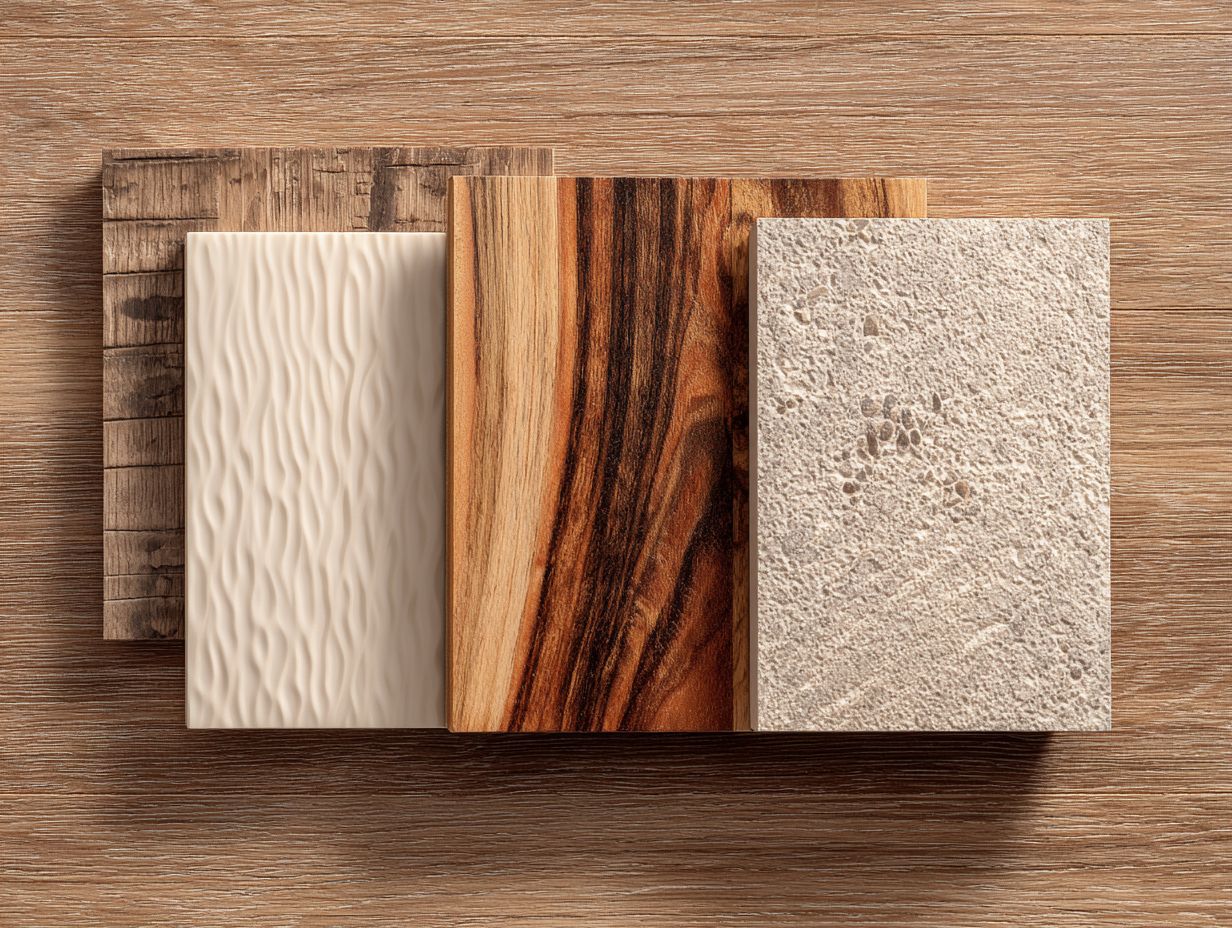
Price is an important factor when choosing textured laminate. Costs vary between $1.50 and $4.50 per square foot based on the texture and brand.
To budget effectively, consider comparing textured laminate options from retailers like Lowe’s and Floor & Design Specialist LLC.
For instance, Lowe’s offers a wide range of styles, and often runs promotions, so check their weekly ads for discounts. Purchasing in bulk can sometimes yield significant savings.
If you’re working with a limited budget, aim for mid-range textures that are frequently discounted.
Trying out samples first can help you pick a product that looks good and fits your budget.
North America Laminate Flooring Market Statistics
North America Laminate Flooring Market Statistics
Market Trends and Projections: Market Size
Market Trends and Projections: Growth Rates
Market Trends and Projections: Sales by Channel
Market Trends and Projections: Imports
Market Trends and Projections: Sector Breakdown
The North America Laminate Flooring Market Statistics give a full summary of market trends, predictions, and how different sectors are doing. The data shows an industry with many factors affecting market size, growth rates, and sales channels.
Market Trends and Projections indicate that the market volume in 2024 is 142.1 million square meters, with a forecasted increase to 183.1 million by 2033. This growth suggests a steady demand for laminate flooring, driven by its affordability and aesthetic appeal. However, a sales decline of 7.5% and a volume decline of 4.8% in 2024 highlight short-term challenges, possibly due to economic factors or shifts in consumer preferences. Despite these declines, a compound annual growth rate (CAGR) of 2.71% from 2025 to 2033 projects recovery and sustained growth.
Market Share analysis shows that laminate flooring holds 7.9% of the hard surface value and 9.5% of the hard surface volume in 2024. These numbers highlight its strong position in the larger flooring market, where it keeps attracting customers because of its practical use and design options.
Sales by Channel reveal significant growth in specialty retail, with a 30% increase in 2024 This shows that people enjoy services made for them and a large range of products. Conversely, warehouse club sales account for only 5%, suggesting limited impact in these less specialized venues.
Examining Imports, there is a notable 19% decline in imports from China in 2024, possibly due to tariff impacts or shifting supply chain strategies. In contrast, a 9% increase in European Producers of Laminate Flooring (EPLF) shipments to the US highlights growing reliance on European suppliers, perhaps due to perceived quality or trade agreements.
Sector Breakdown indicates that the residential sector dominates with 80% of laminate flooring usage, reflecting consumer trends towards home renovations and improvements. Moreover, 12.7% of the market is attributed to new home construction in 2024, signifying a steady demand from the housing market.
Overall, these statistics show a detailed view of the North American laminate flooring market, highlighting both difficulties and chances for growth across different areas and sales channels. It is important for stakeholders to grasp these dynamics to succeed in this competitive market.
Visual Appeal and Design Choices
Visual appeal varies widely among textured laminates, with design choices impacting the overall ambiance of a space.
When selecting a textured laminate, consider how it complements existing decor styles. To create a modern look, use smooth finishes alongside light wood patterns to make it more polished. For more traditional settings, rough textures and worn looks work well.
For instance, pairing a dark, textured laminate countertop in a kitchen can create a striking contrast against lighter cabinets, adding depth. Tools like mood boards or design apps can help visualize these combinations, ensuring that the chosen laminate contributes positively to the overall aesthetic and functionality of the room.
Choosing the Right Textured Laminate
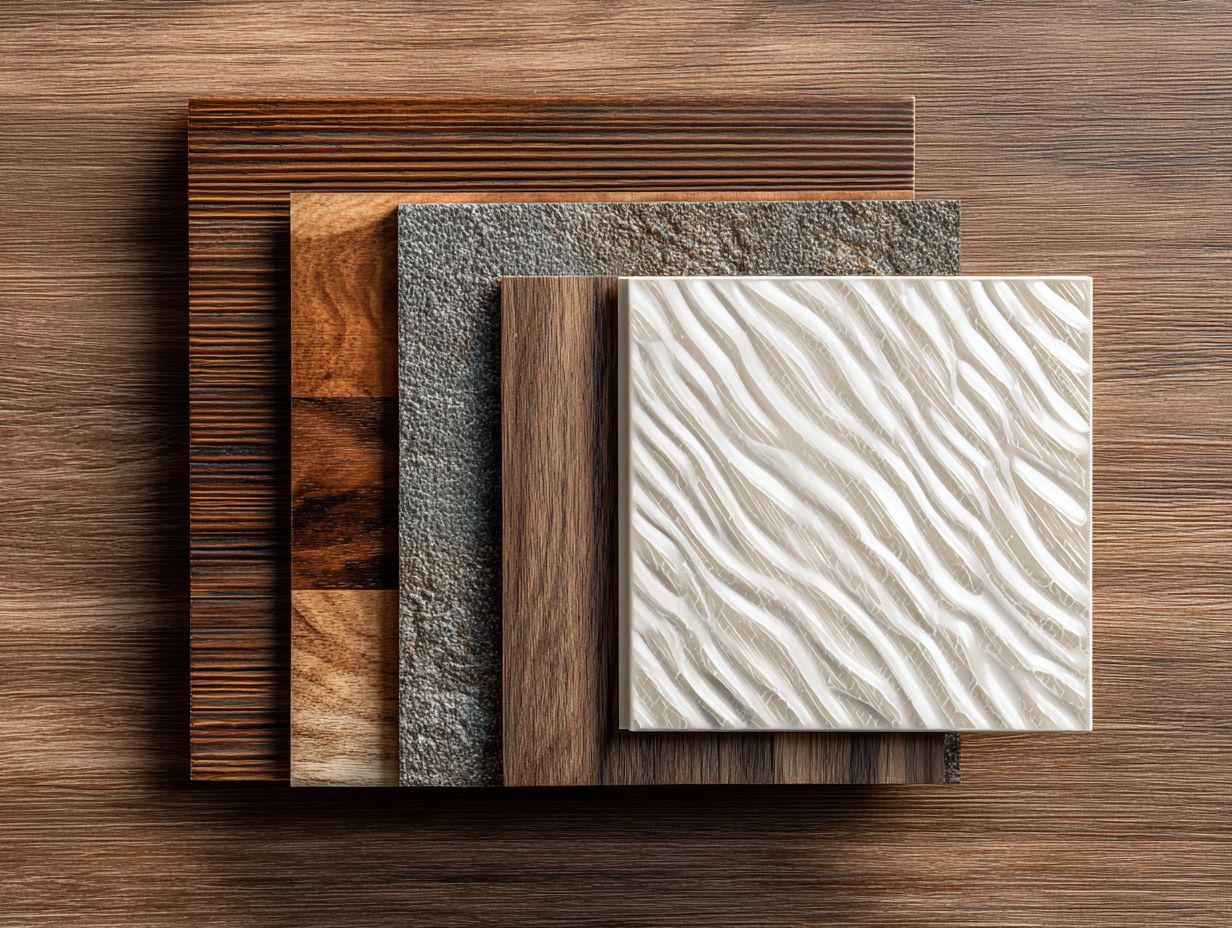
Picking the right textured laminate means considering what you like, how you live, and what each type offers.
Factors to Consider When Selecting Texture
When choosing laminate texture, think about foot traffic, the look you want, and how much upkeep it needs to find what’s right for you.
For areas with a lot of foot traffic, choose a textured finish that improves grip and lowers the chance of slipping, like a wood grain or embossed surface.
To achieve a modern style, using sleek and smooth textures can create a clean and simple appearance. For maintenance, smoother finishes tend to be easier to clean but can show scratches more easily.
Evaluate samples in your space-natural lighting can significantly alter perceptions of texture and color. Ensuring the laminate complements your decor while meeting practical needs will provide long-lasting satisfaction.
Combining Different Textures in Design
Mixing various textures in laminate flooring can increase visual appeal and allow for distinct design choices in any space.
To achieve a stunning effect, consider pairing wider planks with narrower ones, or mixing smooth finishes with distressed textures.
For example, a smooth walnut laminate paired with rough oak can make your space look more appealing.
Use tools like Shaw Floors’ Room Designer or a color swatch kit to see different combinations clearly.
Try different floor designs-diagonal or herringbone styles can change how your floor looks, turning it into a key element in your room.
Frequently Asked Questions
What are the different textured laminate options available?
The three main options for textured laminate are hand-scraped, embossed, and smooth. Each option offers a unique look and feel for your flooring.
What is hand-scraped textured laminate?
Hand-scraped textured laminate is designed to mimic the look and feel of hardwood floors that have been hand-scraped to create a distressed, rustic appearance. This option adds character and charm to any space.
What is embossed textured laminate?
Embossed textured laminate has a raised pattern that creates a realistic wood grain effect. This option adds depth and texture to your flooring, giving it a more natural and authentic look.
What is smooth textured laminate?
Smooth textured laminate has a flat, uniform surface without any texture. This option is great for a more modern and sleek look, and it is also easier to clean and maintain.
Which textured laminate option is most durable?
All of the options have their own benefits, but hand-scraped laminate is generally considered the most durable due to its distressed, textured surface that can hide scratches and wear over time. However, all three choices are built to last through daily use.
Can I mix and match different textured laminate in my home?
You can combine different textured laminate choices in your home to create a one-of-a-kind and customized appearance. For example, you could use hand-scraped laminate in the living room for a cozy feel, and then use smooth laminate in the kitchen for a sleek and modern look.

